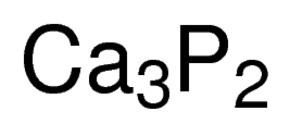Formula Ca3P2 Density 2.51 g/cm³ | Molar mass 182.18 g/mol | |
 | ||
Appearance red-brown crystalline powder or grey lumps | ||
This is how the ionic bond forms in calcium phosphide ca3p2
Calcium phosphide (CP, Ca3P2) is a chemical used in incendiary bombs. It has the appearance of red-brown crystalline powder or grey lumps, with melting point of 1600 °C. Its trade name is Photophor for the incendiary use or Polytanol for the use as rodenticide.
Contents
It may be formed by reaction of the elements. Metal phosphides have been used as rodenticides. A mixture of food and calcium phosphide is left where the rodents can eat it. The acid in the digestive system of the rodent reacts with the phosphide to generate the toxic gas phosphine. This method of vermin control has possible use in places where rodents immune to many of the common poisons have appeared. Other pesticides similar to calcium phosphide are zinc phosphide and aluminium phosphide.
Calcium phosphide is also used in fireworks, torpedoes, self-igniting naval pyrotechnic flares, and various water-activated ammunition. During the 1920s and 1930s, Charles Kingsford Smith used separate buoyant canisters of calcium carbide and calcium phosphide as naval flares lasting up to ten minutes. It is speculated that calcium phosphide—made by boiling bones in urine, within a closed vessel—was an ingredient of some ancient Greek fire formulas.
Calcium phosphide is a common impurity in calcium carbide, which may cause the resulting phosphine-contaminated acetylene to ignite spontaneously.
Safety considerations
On contact with acids or water, calcium phosphide releases phosphine, which is toxic and can cause explosions in air.
